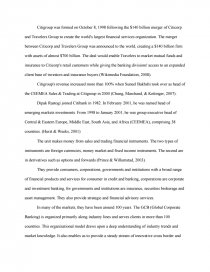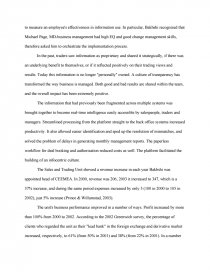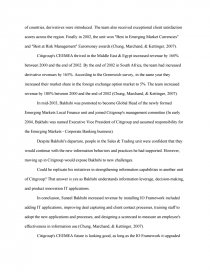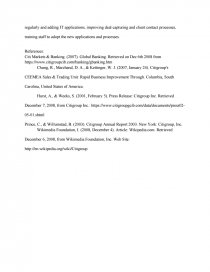Citigroup's Ceemea
Essay by nikky • April 11, 2011 • Research Paper • 1,583 Words (7 Pages) • 9,156 Views
Citigroup was formed on October 8, 1998 following the $140 billion merger of Citicorp and Travelers Group to create the world's largest financial services organization. The merger between Citicorp and Travelers Group was announced to the world, creating a $140 billion firm with assets of almost $700 billion. The deal would enable Travelers to market mutual funds and insurance to Citicorp's retail customers while giving the banking divisions' access to an expanded client base of investors and insurance buyers (Wikimedia Foundation, 2008).
Citigroup's revenue increased more than 100% when Suneel Bakhshi took over as head of the CEEMEA Sales & Trading at Citigroup in 2000 (Chung, Marchand, & Kettinger, 2007).
Dipak Rastogi joined Citibank in 1982. In February 2001, he was named head of emerging markets investments. From 1998 to January 2001, he was group executive head of Central & Eastern Europe, Middle East, South Asia, and Africa (CEEMEA), comprising 38 countries. (Hurst & Weeks, 2001)
The unit makes money from sales and trading financial instruments. The two types of instruments are foreign currencies, money market and fixed income instruments. The second are in derivatives such as options and forwards (Prince & Willumstad, 2003).
They provide consumers, corporations, governments and institutions with a broad range of financial products and services for consumer in credit and banking, corporations are corporate and investment banking, for governments and institutions are insurance, securities brokerage and asset management. They also provide strategic and financial advisory services.
In many of the markets, they have been around 100 years. The GCB (Global Corporate Banking) is organized primarily along industry lines and serves clients in more than 100 countries. This organizational model draws upon a deep understanding of industry trends and market knowledge. It also enables us to provide a steady stream of innovative cross border and local financial solutions tailored to the specific needs of our clients.
Sales and Trading has appointed Suneel Bakhshi. Suneel Bakhshi was in charge of making changes to increase the productivity and revenues of Citigroup's CEEMEA. To improving trade through diversity, a plan to use real-time information was increased. Suneel Bakhshi understood information leverage was needed; there for, decision-making and product innovation IT applications were built. It was aimed at managing fast-moving treasury business and to change the way his team sensed, shared, and used information across the region. In doing this, Bakhshi's team had become more effective and efficient in managing and use of the information provided (Chung, 2007).
Bakhshi's direct superior was Dipak Rastogi. At the time, he was the CEO of CEEMEA and suggested that Bakhshi participate in a Breakthrough Program for Senior Executives so he could gain management insights. Bakhshi then informed his other direct superior, Y.S. Wong, Executive Vice President and global head what he wanted to do and what he learned from the program. Wong's team was asked to collaborate with Bakhshi to enhance the IT applications for the CEEMEA regions treasury business (Chung, 2007).
Citigroup's CEEMEA used IT to support or enable its business processes and competitive strategies in many different ways. Bakhshi thought the information flow in the emerging markets was considered to be highly imperfect and it would be a good idea to increase the use of relevant-time information to help improve trading results across the diverse nation. They built different IT applications for decision-making and at a much faster pace. This ultimately changed the way the team sensed, shared, and used information.
Bakhshi stated that the local markets IT was a sub-optimal issue and information was not used as efficient as it should be. Risk management was not a monitored process due to system fragmentation of across the region. In most ways, the company would report everything manually and that's how errors could occur. Also, there weren't any databases that would collect and preserve their customers' information. With all these different issues that needed to be addressed, Bakhshi implemented infocentricity an innovative system that would correct many of the problems that the company was having also would make everything efficient along with benefit the company.
To be considered a competitive strategy and improve business the upgrades that were implemented into the business were different strategies. Many programs are built to customize the needs of the business and can help improve the business.
In June 2000, Bakhshi's direct superior, CEO of CEEMEA Dipak Rastogi, recommended he partake in the Breakthrough Program for Senior Executives at IMD in Lausanne, Switzerland, so Bakhshi can gain management insights. Bakhshi heard Professor Donald A. Marchand explaining the Information Orientation (IO) Framework 7. He agreed with the concept that an organization could improve business performance if it increased how well it effectively managed and used information (IO Maturity), knowledge, people, and IT capabilities.
Bakhshi enlisted people whom he knew and trusted to be his direct reports, and invited Professor Marchand to present the IO Framework. He wanted his new management team to diffuse the concepts behind the IO Framework throughout the unit.
Professor Marchand also measured
...
...





